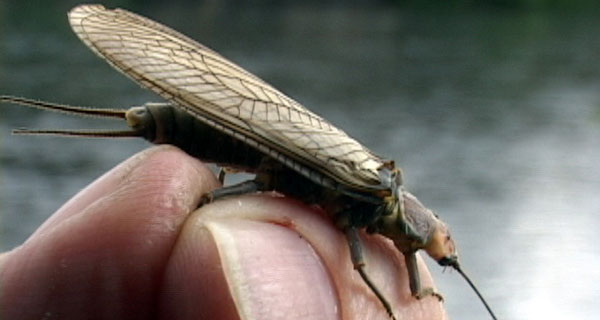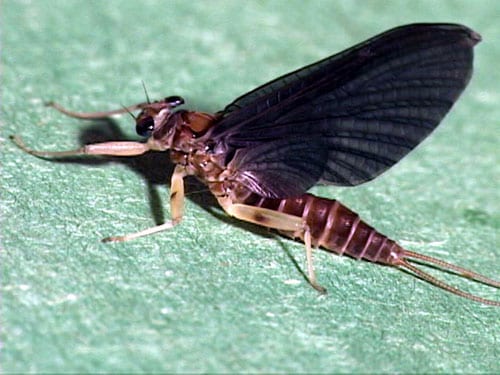
By James Marsh
This is the same Watauga River but it’s the headwaters that lies above Boone Lake in North Carolina, rather than the Watauga tailwater below Wilbur Dam, that’s so popular and well known. The problem with the uppermost parts of the Watauga River in this area is access, or I should say the lack of it. Most of the stream runs through private property; however, the parts that are on public land are worth fishing. The stream holds brook, brown and rainbow trout.
The Watauga River starts out at the bottom of Grandfather Mountain in North Carolina at Banner Elk, North Carolina, near Boone. From its beginning downstream to North Carolina #1580, the stream is under the state’s wild trout regulations. It’s very small and there’s little water to fish because above the bridge at Highway #1580, it flows mostly through private property. From the North Carolina #1580 bridge downstream to the mouth of Boone Fork Creek, a tributary stream, it flows entirely on private property.
From the North Carolina Highway #1557 bridge to the Highway #105 bridge, and from North Carolina #1114 bridge to the North Carolina #194 bridge at Valle Crucis, the stream falls under the state’s “Delayed Harvest” regulations. There’s about two miles of fishing in the “Delayed Harvest” section.
North Carolina Highway #105 runs along the stream for over a half mile just above the bridge in this section. Upstream from that point, Shulls Mill Road follows along the river for almost a mile in the “Delayed Harvest” section. Access is easy from the Shulls Mills Road with plenty of parking areas and spaces.
The Watauga isn’t exactly a small stream in the “Delayed Harvest” area. It’s rather large, averaging about forty feet wide and even wider in places.
The river flows along a golf course in one area. It flows on a low decline in this area and is open enough that casting isn’t a problem. It has plenty of large boulders and rocks distributed throughout its waters creating many holding places for the trout.
There are plenty of both wild and large holdover trout in the upper Watauga River in the “Delayed Harvest” area and above there, in the headwaters. It’s a good place to catch a large brown trout. It’s by no means a great destination stream, but one well worth fishing if you are in the area.
Upper Watauga River Hatches and Trout Flies:
Our information on aquatic insects is based on our stream samples of larvae and nymphs, not guess work. We base fly suggestions on imitating the most plentiful and most available insects and other foods at the particular time you are fishing. Unlike the generic fly shop trout flies, we have specific imitations of all the insects in the Upper Watauga River and in all stages of life that are applicable to fishing. If you want to fish better, more realistic trout flies, have a much higher degree of success, give us a call. We not only will help you with selections, you will learn why, after trying Perfect Flies, 92% of the thousands of our customers will use nothing else. 1-800-594-4726.
The Upper Watauga River has a very diverse population of aquatic insects that hatch throughout most of the year. There are several mayflies and caddisflies that reside in the river that you wouldn’t expect to find in most Eastern Appalachian mountain freestone streams.
The most consistent hatch is the usual Blue-winged Olives. There are several species that hatch months of the year. The best hatches start in February and last through June. There is a second hatch that occurs in October and early November.
Little Black Winter Stoneflies start the first hatches of the year in late January. These can hatch into March. Little Brown Stoneflies (actually in the same family as the Little Blacks) hatch in March and until the middle of April.
The Giant Black Stoneflies start hatching the third week of April. It can last for six weeks. The Yellow Sallies start a couple of weeks later and hatch into the first of July. The Yellow Sallies are plentiful.
The Golden Stoneflies start about the last week of May and can hatch until the last week of June. These are sparse hatches.
One of the first mayflies to start hatching are the Blue Quills. They start about the first of March and can last until the middle of April.

Quill Gordons start about the same time and last about a month. This is one of the better hatches.
The Hendricksons start hatching about the first of April. The hatch last about a month but is usually not very heavy but enough to get the trout’s attention.
American March Browns start hatching near the end of April and last almost two months. This hatch is never concentrated but well worth imitating.
Eastern Pale Evening Duns start hatching around the first of May and last through June
About two weeks after this hatch starts, the Sulphurs start hatching and last almost two months. Locals refer to both of these hatches as Sulphurs and they are very similar.
There are also plenty of Light Cahills that hatch in late May and June. You will find them in the faster water.
Slate Drakes start hatching in late June and continue on through September. These large mayflies are very important to imitate.
Mahagony Duns start hatching in late August and last for about two months. There are a few Grannon Caddisflies that hatch in March. The hatch lasts about a month.
Green Sedges are fairly plentiful in the creek. They normally hatch from about the first of May through June. There are also some Little Short-horn Sedges that hatch near the same time.
The Cinnamon Sedges and a few Spotted Sedge species of caddisflies hatch from about the first of May through July. These are the most important caddisflies. They are plentiful in some areas of the creek.
The Great Autumn Brown Sedges start hatching in October and can last until December.
Summertime is terrestrial time and imitations of grasshopper, ants and beetles. Inchworms also are plentiful and fall and get blown into the water. The terrestrial become important about the middle of June through September.
Midges hatch throughout the entire year but are most important during the winter.
Streamers are effective in the creek, especially when the water is slightly high and stained. Imitations of sculpin, small minnows and small crawfish will work great at times.
James Marsh is the Owner of The Perfect Fly online and catalog mail-order store. www.perfectflystore.com